Movie Summary and Analysis: ‘The Silence of the Lambs’
Looking to further understand the classic horror film, “Silence of the Lambs”. This article breaks down famous scenes, characters, plot and more.

The Silence of the Lambs (1991) is a psychological horror film that is regularly cited by critics, film directors, and general audiences as one of the greatest and most influential films of all time. Most notably, it was the first and only horror film to win the “Big Five Awards” at the Oscars — Best Picture, Best Director, Best Actor, Best Actress, and Best Screenplay. Only two other movies have achieved this honor: It Happened One Night (1934) and One Flew Over the Cuckoo’s Nest (1975).
“The Silence of the Lambs” (1988) was originally written as a novel by Thomas Harris and was a sequel to Harris’ novel “Red Dragon” (1981). The Silence of the Lambs was adapted by director Jonathan Demme in 1991 and the screenplay was written by Ted Tally. This movie had a budget of $19 million and made $272.7 million in the box office.

This complete analysis of the film will dive into the meaning of The Silence of the Lambs: the characters, a plot summary, the story, the symbolism, the music, and everything else that makes this horror movie so suspenseful and iconic. Clearly this article is filled with spoilers.
Trailer
The Silence of the Lambs trailer is pretty creepy, but sets you up for the movie pretty well. The trailer opens with loud and scary music as well as serial killer, Dr. Hannibal Lecter’s, face popping up on the screen. It then flashes to FBI rookie, Clarice Starling, who is headed to talk with someone in a jail cell. As she walks towards the jail cell, a narrator states that a “killer is on the loose” and then the trailer flashes to scenes that show newspaper headlines of killer, Buffalo Bill, abducting and murdering women. The trailer then focuses back on Clarice walking towards a jail cell, while the narrator explains that Clarice is on Buffalo Bill’s trail. As an audience, we can assume that whoever’s jail cell Clarice is walking towards might be helpful in finding Buffalo Bill. Then the narrator explains that in order for Clarice to catch Buffalo Bill she will have to “match wits” with serial killer Lecter who is imprisoned in jail. Yet, while Lecter may be the key to finding and arresting Buffalo Bill, he is also an insane and murderous psychotic killer. The trailer then proceeds to show more intense and epic clips from the movie and leaves us wondering will Clarice find Buffalo Bill? Will Lecter truly help Clarice? Or will Hannibal Lecter be able to manipulate and outwit our brave FBI agent?
Movie Poster

The Silence of the Lambs movie poster is one of the most iconic and highly recognized posters in the world. One of the first things you notice about the poster is the woman’s face as it takes up a majority of the poster space. Her white face against the dark background is rather eerie, but also suggests a certain innocent charter attribute. The white color could symbolize virtue and goodness, but is very sharply juxtaposed by the bright red eyes and the brightly colored mouth on her face. From here, we can interpret this woman as The Silence of the Lambs protagonist, Clarice Starling, as we eagerly find her to be heroic and valiant. Yet, the red eyes and moth could suggest that Clarice is either in danger or dangerous. Perhaps she is not who we think she will be. Maybe she becomes manipulated by Dr. Hannibal Lecter throughout this insane investigation and loses part of herself. This woman on the poster can also be interpreted to represent the general idea of ‘women’ in this film. Due to the fact that Buffalo Bill targets women in his murderous plots, all women are in danger. The red eyes could represent blood and death, where as the moth across the woman’s face could represent these women being silenced forever. Speaking of which, the moth is probably the most important and interesting aspect of the movie poster. While the moth is a direct reference to the moth cocoons that are found in all of Buffalo Bill’s victims, its’ symbolism extends farther than this direct link. Upon first glance, it looks like the moth has a skull on its back. While a skull is clearly a symbol of death, upon further analysis you can see that the ‘skull’ is composed of naked humans. This nakedness and body dysphoria is a critical part of the movie and acts to highlight the troubled motive of Buffalo Bill. The bright red and yellow colors of the moth on the poster not only call attention to the significance of this image, but also create an electrifying visual response that is appropriate for this psychological and twisted thriller.
Movie Summary
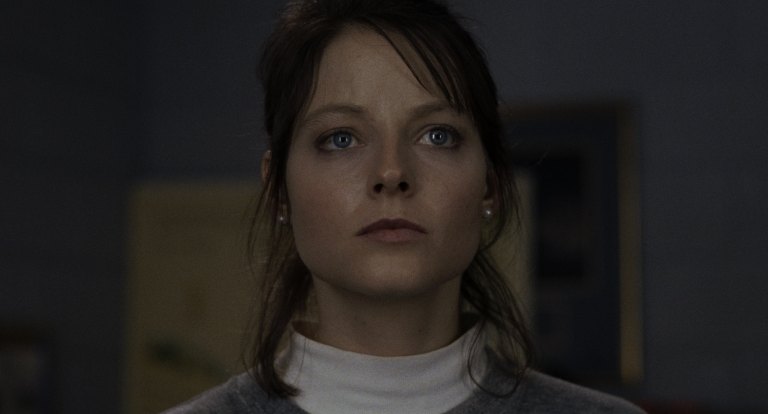
FBI rookie, Clarice Starling, is an eager student at the Academy and hopes to one day work at the agency’s Behavioral Science Unit. Jack Crawford, who is in charge of the Behavioral Science Unit, asks Clarice to visit the cannibalistic murderer Dr. Hannibal Lecter at a maximum security psychiatric prison. Although Clarice does not know it at first, Crawford hopes that Lecter will provide a clearer picture of the new psychopathic serial killer, Buffalo Bill’s, modus operandi. Buffalo Bill has already killed five victims, all of which are slightly overweight young women and were stripped of large portions of their skin. Crawford and his team have been on Buffalo Bill’s trail for a while, but have had no real breakthroughs. After speaking to Lecter for the first time, Clarice realizes that in order to solve the case she will have to play along with his psychological games. More importantly, she will have to figure out how much she will play along, as in return for his insight he requests that Clarice tell him about her past and emotionally open up to him.
The case takes a major turn when they discover that the sixth victim had a rare Death’s Head Moth purposefully placed in her throat. With this key piece of evidence as well as Lecter’s analysis of Buffalo Bill’s case file, Clarice and the FBI must hurry to search for Buffalo Bill’s seventh victim, Catherine Martin. In the end, Lecter escapes from custody, Clarice finds Buffalo Bill’s lair and kills him right before he tries to kill her. Clarice graduates from the Academy and during the graduation reception she receives a cryptic phone call from Lecter.
Characters
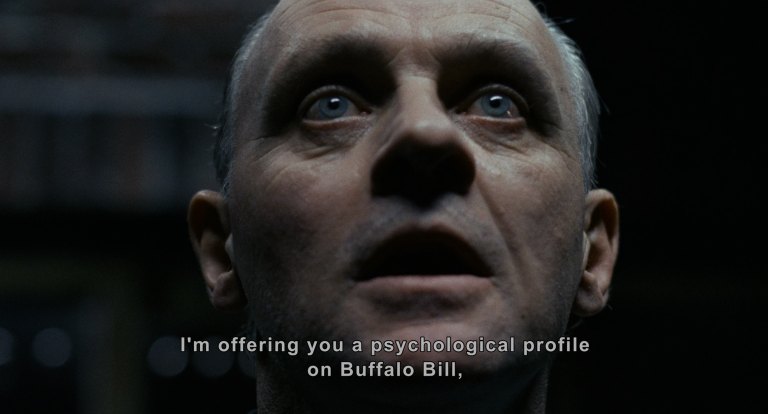
The Silence of the Lambs not only has an incredible cast, but more so Jodi Foster and Anthony Hopkins have received global recognition for their knockout roles. The character list is as follows:
- Jodi Foster plays the lead FBI rookie, Clarice Starling.
- Anthony Hopkins plays the brilliant psychologist yet cannibalistic, psychotic killer Dr. Hannibal Lecter.
- Ted Levine plays the key murderer of the film, Jame Gumb or Buffalo Bill.
- Scott Glenn plays Agent-in-Charge of the Behavioral Science Unit of the FBI, Jack Crawford. He is the one who gets Clarice involved in the case.
- Anthony Heald plays the General Administrator for Baltimore State Hospital for the Criminally Insane, Dr. Frederick Chilton. He is considered Dr. Hannibal Lecter’s nemesis in the film.
- Brooke Smith plays Catherine Martin, who is abducted by Buffalo Bill
- Kasi Lemmons plays Ardelia Mapp, who is Clarice’s friend and confidant at the FBI academy.
- Frankie Faison plays Barney, who is the Head Orderly at the Baltimore State Hospital for the Criminally Insane.
In terms of character analysis, Clarice is our lead protagonist and Buffalo Bill is our main antagonist. While Lecter is clearly a villainous figure in the movie, he is not as seemingly malicious as Buffalo Bill. Perhaps it is because he is intrigued and fascinated by Clarice and does not want to harm her. It could also be because he values and contributes to some aspects of society, even though he defies them at other points. Furthermore, it could also be because he provides useful advice for finding Buffalo Bill and is essential in solving the case.
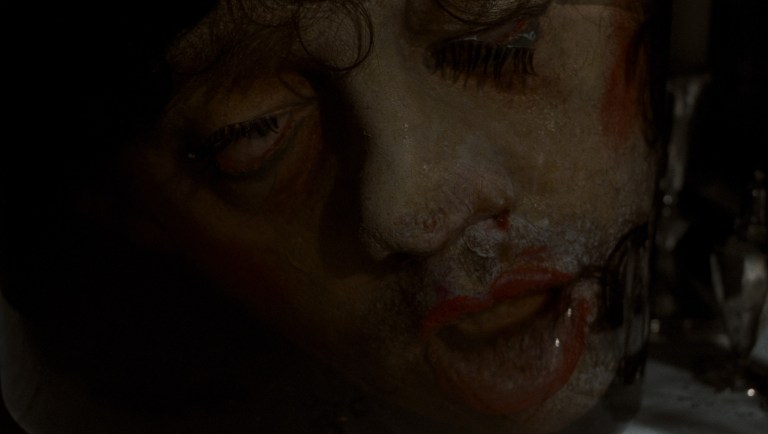
There are also interesting cameo appearances made throughout the film. Danny Darst, who played Sargent Tate, is known for his career as a singer and songwriter. Chris Isaak, who played a SWAT commander in the film, is also an American musician and is widely known for his hit “Wicked Game,” as well as the songs “Baby Did a Bad Bad Thing” and “Somebody’s Crying.” Furthermore, Edward Saxon, one of the film’s producers, also makes an appearance in the film and can be seen as Benjamin Raspail’s severed head, which is found in a jar in Lecter’s storage unit. Lastly, Ted Tally, who is the film’s screenwriter, makes a short appearance as a SWAT Team Member.
Why is it a Classic?
The Silence of the Lambs is a profoundly mesmerizing film and a truly chilling masterpiece of horror. It is a classic because it manages to showcase the terrifying, yet also deeply realistic aspects of the human condition. In this movie, we are brought into the madness of psychoanalyzing a killer in order to find another killer. By traveling deep into the mind of a madman, we must reevaluate our world and ourselves. Most impressionably, this movie tends to stay in your thoughts after you watch it. While it is horrifically brilliant, it is more so psychologically distressing. Furthermore, this movie will always remain iconic as it was the third film in Hollywood history to sweep the top five categories at the Oscars, after It Happened One Night (1934) and One Flew Over the Cuckoo’s Nest (1975).
Famous Scenes
Meeting Dr. Hannibal Lecter: Clarice goes to the Baltimore State Hospital for the Criminally Insane to meet and talk with Dr. Hannibal Lecter. As soon as she walks in front of his cell, you can tell he is already evaluating her every move. They exchange small talk and eventually she tries to get him to fill out a questionnaire. Yet, he instead chooses to dissect and analyze every part of her being, including her wardrobe, her past, and her country upbringing. Clarice then challenges him to take that high powered lens and look at himself. Here is one of the first instances where we see Clarice act valiantly and strong in the face of adversity.
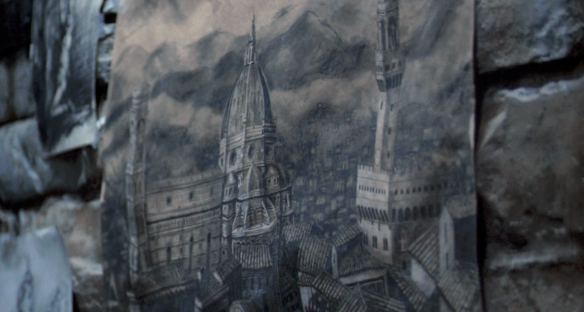
Hannibal Lecter Drawings in his Cell: There are many drawings in Lecter’s jail cell, but the one that stands out the most is The Duomo seen from the Belvedere in Florence, Italy. In this scene, Lecter dives into how all he has left is his memory. He has no view and that is precisely what he wants most. He then elaborates on how he wishes for a view of trees or of water. Lecter makes it clear he wants out of the Baltimore State Hospital for the Criminally Insane and wants to be far away from his nemesis, General Administrator Dr. Chilton. His desire for scenery and change becomes an essential bargain point in the Buffalo Bill case.

Why Buffalo Bill?: The name “Buffalo Bill” started as a bad joke in Kansas City Homicide Department. Due to the fact that Buffalo Bill removes the skin from his victims, the department joked that, “this one likes to skin his humps.” Originally, Clarice hypothesizes that Buffalo Bill keeps his victim’s skin because it entices him and acts as a trophy. This scene is important because we realize that Lecter may actually know Buffalo Bill’s true identity.

Finding Hannibal Lecter’s Storage Unit: After Lecter and Clarice meet for the first time, Lecter advises Clarice to, “Look deep within yourself, Clarice Starling” and to go seek out one of his old patients named Miss Mofet. As Clarice starts to learn Lecter’s games, she realizes that he is referencing the Your Self Storage Units. Clarice goes to the Your Self Storage Unit and discovers that Unit 31 has been leased for 10 years and has been prepaid in full under the name Miss Hester Mofet. In the back of the unit, she finds a decapitated head in a jar. We later learn that the head belonged to Benjamin Raspail, an old patient of Lecter. When Clarice goes back to the Baltimore State Hospital for the Criminally Insane to speak with Lecter about what she found, we learn that Lecter didn’t kill Raspail that Raspail’s death was “a fledgling killer’s first effort at transformation.” We later learn that Buffalo Bill and Raspail were lovers, which is how Lecter knows of Buffalo Bill.
Lotion: Buffalo Bill has abducted Catherine Martin and is keeping her in a pit in the basement of his house. He is keeping her alive for a couple days and is starving her so that her skin will loosen up. Furthermore, he is demanding that she put lotion on her skin so it is soft when he skins her for the woman suit that he is constructing. What’s particularly important about this scene is the way that Buffalo Bill refers to Catherine as “it.” He yells at her and demands that, “It rubs the lotion on its skin. It does this whenever it’s told.” By referring to her as “it,” he is disassociating her skin from her personhood. In other words, by seeing her as an “it” rather than as a whole person with a life and feelings, she becomes more of an object than a human.
Fun Fact: A popular reference to this scene can be see by The Elf on the Shelf, where people have positioned a naughty elf to act like Buffalo Bill.
Hannibal Lecter Meets Senator Martin: Lecter is taken to speak with Senator Martin as she is offering him a deal if his insight can lead to her daughter’s rescue. In this scene, Lecter asks if the Senator had breast-fed Catherine. He asked how it felt and directly asks if it toughened her nipple. Lecter then swiftly mocks that when her daughter is on the slab, where will she [the Senator] be tickled then? While this comment is of course incredibly insensitive, this scene is important because it highlights a larger theme in the film that discusses womanhood and misogyny (we will dive into that more later).
Screaming Lambs Memory: In this scene we get an in depth look at Clarice’s past. As Clarice opens up to Lecter, we not only find out that she was orphaned, but before she was sent away she used to live with her aunt and uncle on a sheep and horses ranch. Clarice dives into the night where she awoke to a strange noise. When she went outside to investigate, she uncovered that the noise was the soon-to-be slaughtered lambs screaming. Clarice explains that at first she tried to free them, but they wouldn’t run. Feeling completely helpless, she took one lamb and ran away as fast as she could. However, she didn’t get far. Her uncle was so angry with her that he that sent her to live in an orphanage. This allegory is signifiant because it gives us our movie title. Lecter questions if Clarice ever wakes up in the dark and still hears the screaming of the lambs. She says yes. Lecter then asks if she is able to save poor Catherine Martin from Buffalo Bill, will the screaming stop? Thus giving us the title, The Silence of the Lambs, as Clarice’s childhood story symbolically represents her desire to save those who are innocent and trapped. She failed in the past and has suffered ever since. As an audience, we are meant to believe that Clarice is determined not to fail this time.

Face Mask: In an alarming turn of events, Lecter escapes confinement by picking his handcuffs and then attacking the officers that came into his cell. There is a fair amount of foreshadowing in this scene and we can tell something significant will happen as 1) we find out that this is Lecter’s SECOND dinner of the evening (i.e. he must be up to something) and 2) he orders lamb (medium rare), right after Clarice and him spoke about her traumatic past and the screaming of the lambs. Lecter gets away by removing the face of one of the policeman and putting it on top of his own. After killing the officer, Lecter also trades outfits with the him so that he will be whisked away on an ambulance once the guards find out that he has escaped. As part of his brilliance, Lecter leaves the faceless policeman in his prison outfit on top of an elevator. While the prison guards find what they believe to be Lecter on top of the elevator, the real Lecter reveals himself in the ambulance and kills the ambulance crew. This scene is essential because we see the use of skin once again acting as a disguise and being taken from one person and put on another.
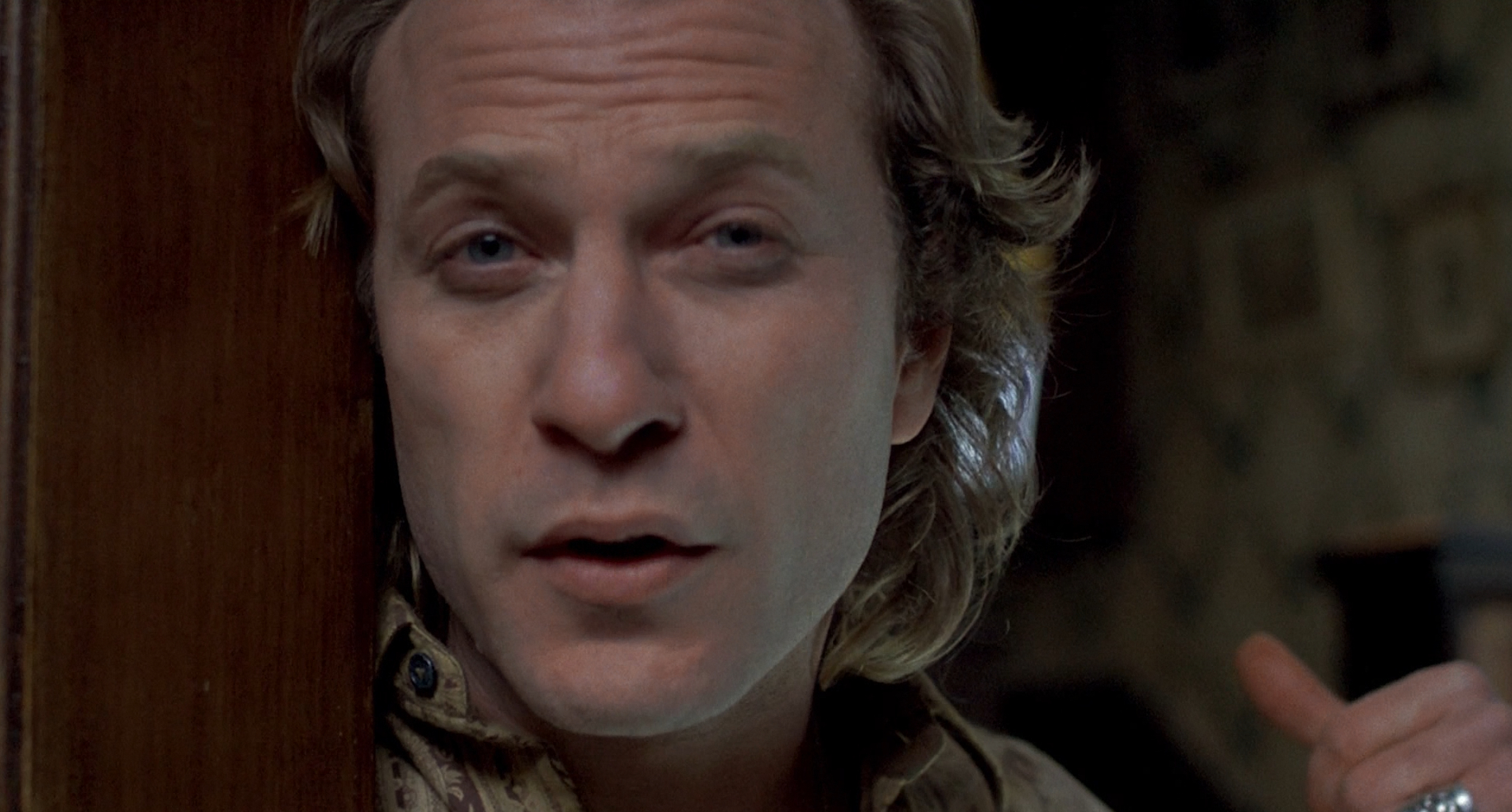
Dance and Tuck Scene: In this scene, Buffalo Bill is putting on makeup and is seductively moving around. He also sets up a camcorder and dances to the 1988 Q Lazzarus song “Goodbye Horses.” In the middle of the dance, he takes a pause during the song to tuck his penis in between his legs. Then saunters away from the camera with his penis tucked in between his legs so it looks like a vagina. This scene is important as it portrays his body dysmorphia and desire to appear feminine. What is most fascinating about this scene is that it is a contrast to what the film portrays about being woman. We watch women in this movie struggle and face sexism and abuse, yet in this scene Buffalo Bill is emulating the feminine aesthetic and romanticizing the female figure. The final frame is probably the most essential part of the scene. Here we see a naked Buffalo Bill with his penis tucked and his shawl acting to make it look like he has wings. This final frame goes to suggest metamorphosis and change, like the moths.

Finding Buffalo Bill: Clarice finds Buffalo Bill’s house after getting a lead from an old friend of Franietta, who was one of Buffalo Bill’s victims. As she is in his house, she notices a moth by a bunch of colored thread and the pieces start to come together. She then orders Buffalo Bill to freeze and he the proceeds to run back down to his basement. In pursuit, Clarice goes down there and sees the body suit that he is making. As she walks around the various parts of his lair, she finds Catherine in the pit as well as the room where he raises the moths.
The Blackout in the Basement (The most terrifying scene): Buffalo Bill then kills the lights so Clarice can’t see, but he has his night vision binoculars so he is able to sneak up on her. What is interesting about this scene is that much of the camera work involves looking at Clarice through Buffalo Bill’s eyes (i.e. through the night vision binoculars). We watch as he slowly walks towards her and the whole scene is incredibly suspenseful and terrifying. More so, we watch his hand move over her face, essentially taunting how close he is to her. We then see the gun pointed at her. However, as soon as he takes the safety off of the gun, Clarice sharply turns around and shoots at him. It’s a direct shot, the lights come back on, and we see that Buffalo Bill is now dead.

Ending: In the end, Clarice becomes a Special Agent and at the reception of her ceremony she gets a phone call. The call is from Lecter and he asks, “Well, Clarice, have the lambs stopped screaming?” He also shares that he does not want to harm her as the, “world is more interesting with you in it.” Lecter then says that he is having an old friend for dinner. The shot then directly moves to Dr. Chilton (remember him? He is the General Administrator for Baltimore State Hospital for the Criminally Insane) getting off a small plane in a tropical climate. The film ends as we watch Lecter closely following Dr. Chilton.
Main Themes

On Being A Women: In The Silence of the Lambs, there are SO many examples of sexism, misogyny, and toxic masculinity. This theme is constantly thrown around in the film and is most likely prevalent because our main protagonist is young and female. Here our are top examples of undermining strong women in this film:
- When Clarice goes to visit Lecter for the first time and meets with Dr. Chilton, he instantly hits on her and asks where she is staying later. He creepily comes on to her and creates a strange and unwanted dynamic.
- On the way to Lecter, Miggs (one of the other prisoners) hisses at Clarice that he can smell her c*nt. After speaking with Lecter, Miggs then throws semen at Clarice. This is a direct case of male assault and sexual harassment.
- On the second time Lecter and Clarice meet, he challenges Clarice and asks if Crawford thinks of her sexually.
- Clarice and Ardelia are running and the male FBI trainees are checking them out. Again, showing that even in the place of work, women are sexualized.
- During the funeral in West Virginia, there is a scene of all the male policemen looking at inquisitively at Clarice. Almost wondering what she is doing there. Crawford then excuses himself and the sheriff to talk about the case because this, “type of sex crime has certain aspects.” While Crawford later explains to Clarice that pulling the sheriff away was just a technique to get rid of him, Clarice explains that it matters how women are treated because, “Cops look at you to see how to act.” It’s good we see Clarice stand up for herself here, but it begs the question why did she have to be excluded in the first place?
- Lecter asking if the Senator Martin if he had breast-fed Catherine and if it toughened her nipple.
- When the lights go out at Buffalo Bill’s lair, we see Clarice through Buffalo Bill’s night vision binoculars. While she is in the pitch black and can’t see, we see how truly terrified she is and we watch her stumble around. In a sense, her movements mimic the stereotypical female character type in horror movies — afraid, clumsy, and helpless.

Cross Dressing/Escapism: Throughout the film, the theme of change and departing from one’s reality plays a large role. We walk around in the world in our skin and live our lives in our body. In a sense, our skin is our dress. Now imagine that you don’t like the skin that you are in. Perhaps, more than anything else, you want to experience what it feels like to be in someone else’s skin. This is exactly the case with Buffalo Bill. Lecter explains that “Billy is not a real transexual. He thinks he is and he tries to be.” Furthermore, he wasn’t born a criminal, he was made into a criminal after years of systematic abuse. As a whole, Buffalo Bill hates his own identity and he thinks that makes him a transexual. By skinning these women and wearing their skin, he hopes he will be able to escape reality.
Abandonment: The theme of abandonment and the death of the innocent play a large role in The Silence of the Lambs. Clarice lost her mother very young and then she lost everything when she lost her father. After not being able to save the screaming lambs, she has a strong connection to save others and bring people back together. Clarice knows what it is like to be left with nothing and not being able to save someone. Therefore, this film is charged by Clarice’s energy to stop Buffalo Bill and find Catherine Martin. While she must face her fears and match wits with Lecter, she is determined not to abandon the innocent and the helpless this time.
Symbolism
Moths/Cocoons: As the moth is such a focus piece on The Silence of the Lambs movie poster, it is no surprise it is such an important symbol in the film itself. In this film the significance of the moth is change. More specifically, it is changing from something ugly to something beautiful. With that being said, it makes sense why it is such a staple image for the film. Buffalo Bill utilizes the key symbolism of the moth in regards to his personal transformation, but also as his calling card after he murders a victim. During an autopsy of one of his victims, Clarice finds a Death Head Moth in the back of the victim’s throat. So, why the throat? This can contribute to the idea of silence and keeping secrets and desires inside. While Buffalo Bill has permanently silenced these women by killing them, he also parallels his own inner transformation by putting these cocoons in the women who he has skinned. The cocoon also symbolizes growth and change, which again is tied to Buffalo Bill and his changing body image. Lastly, the idea of the moth/cocoon can also be tied to Clarice as she grows throughout the case. She grows more confident and assured throughout the film, thus this cyclical moth symbolism applies to her as well.

Skin: In The Silence of the Lambs, skin plays an essential role in shaping the film’s meaning. In the film, human skin symbolizes an escapism from reality and allows the wearer to achieve a certain motive. Furthermore, skin can also represent an outfit and appearance. What the wearer looks like and how they present is also a critical aspect of this film. Both interpretations can directly be seen in the film:

- Looking at Buffalo Bill’s victims, skin is removed from this victims after he kills them. He is skinning these women in order to construct a woman suit made out of real skin.
- Buffalo Bill refers to his victims as ‘It.” This is a dissociative measure, allowing him to view his victims as simply flesh and skin. Nothing more.
- When escaping confinement, Lecter removes the face of one of the guards. Here, Lecter pretends to be someone else and uses the guard’s skin as a motive to escape.
- When Lecter speaks with Senator Martin, he ends the conversation by saying to the senator, “Love your suit.” Senator Martin is a woman and this remark by Lecter not only mirrors Buffalo Bill’s evil plan, but more so highlights dominant male gaze and its focus on the physical properties of womanly beauty.
- In regards to appearance and outfit, upon first meeting Clarice, Lecter criticizes her wardrobe and cheap shoes. He also analyzes her accent and notes that she is trying to hide her West Virginia roots. Lecter speculates that she believes this country appearance would automatically classify her as being backward or white trash.
Lambs: Clarice tells Lecter the story of the screaming lambs from her childhood. As a whole, these lambs represent the innocent, the helpless, and the trapped. In Clarice’s story, the lambs are destined to die. She even shares that she still wakes up in the middle of night hearing the screaming of the lambs. This story directly parallels her choice to be an FBI agent, as she wants to save others (unlike she could with the lambs). Specifically looking at Catherine Martin’s case, Lecter wonders if saving Catherine will stop the lambs from screaming and will set Clarice free. Essentially, will her past demons and regrets be silenced if she can now save others?

How the Film Builds Suspense
Misdirection: Misdirection is a technique that is used quite a lot in The Silence of the Lambs. In the film, the filmmakers will show two scenes happening at the same time and make the viewer think that it is playing out in a certain way. However, this film is full of suspense and thrill, so naturally the filmmakers can’t let it get too predictable. Misdirection allows the audience to fall into a false sense of security and believe something to be true until the last moment.
- In Lecter’s escape scene, we think that he is dead on top of the elevator and the bloodied guard is safe in the ambulance. When in reality, Lecter removed the guard’s face and is off free in the ambulance and the guard is in Lecter’s prison suit and is dead on top of elevator.
- In the scene where the FB is preparing to swarm a house and ringing the doorbell, we see Buffalo Bill running around in his basement upset that Catherine has trapped his dog and aggravated by the doorbell that is ringing. Naturally we think that the FBI have found Buffalo Bill’s lair. Yet, once we see the FBI break into the house, we realize it is not Buffalo Bill’s house. Our fear is then confirmed once Buffalo Bill answers the door we see that it is Clarice alone outside ringing his doorbell.
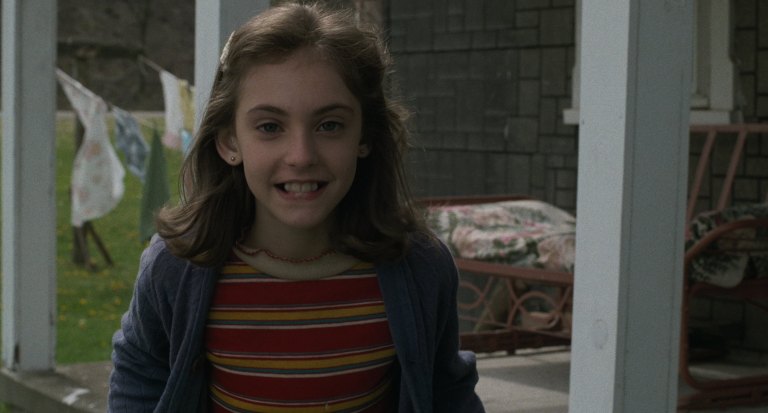
Flashbacks: In the film, flashbacks play the important role of showing the viewer some insights of the character’s past. Through these flashbacks, we learn about Clarice’s emotional baggage.
- After Clarice leaves the insane asylum prison, she has a flashback of her dad (a cop) returning from work. From the memory, you can tell that her dad was incredibly important to her. The scene then cuts back to the present and we see Clarice crying in the parking lot.
- At the West Virginia victim’s funeral, Clarice is walking towards the female body, but then the shot transitions to her walking towards a male body. As we get closer to the male body, we see a young Clarice looking down at her deceased father.
Score/Soundtrack
The Silence of the Lambs score was produced by Howard Shore. It is strikingly haunting, but beautiful at the same time.
- “Munich Symphony” -5:09
- “The Asylum [feat. Munich Symphony]” – 3:58
- “Clarice [feat. Munich Symphony]” – 3:07
- “Return To The Asylum [feat. Munich Symphony]” – 2:39
- “The Abduction [feat. Munich Symphony]” – 3:05
- “Quid Pro Quo [feat. Munich Symphony]” – 4:44
- “Lecter In Memphis [feat. Munich Symphony]” – 5:45
- “Lambs Screaming [feat. Munich Symphony]” – 5:38
- “Lecter Escapes [feat. Munich Symphony]” – 5:09
- “Belvedere, Ohio [feat. Munich Symphony]” – 3:36
- “The Moth [feat. Munich Symphony]”- 2:22
- “The Cellar [feat. Munich Symphony]” – 7:06
- “Shore: Finale [feat. Munich Symphony]” – 4:53
The soundtrack also included songs such as Tom Petty’s “American Girl” (1976), “Alone” (1980) by Colin Newman, “Sunny Day” (1991) by Book of Love, “Real Men” (1981) by Savage Republic, ” Goldberg Variations” (1741) by Jerry Zimmerman, and “Hip Priest” (1981) by The Fall.
“Goodbye Horses” song: the most memorable song of The Silence of the Lambs is the song “Goodbye Horses” (1988) by Q. Lazzarus. More commonly-known versions of this song are performed by Psyche and by Mortal Loom sung by Ilja Rosendahl. This is the song played as Buffalo Bill performs his crossdressing monologue and seductively dances around his lair. This iconic scene, while incredibly creepy, also perfectly showcases the body dysmorphia and internal struggle that Buffalo Bill endures. The song itself explains that if you transcend the limitations of your senses and achieve a higher level of consciousness, you are leaving the “horses” behind and are “flying over them.” Essentially, the song is about someone who was affected by something so terrible that they decide to give up on the things that keep them attached to the world.
You told me, I see you rise
But, it always falls
I see you come, I see you go
You say, “All things pass into the night”
And I say, “Oh no sir I must say you’re wrong
I must disagree, oh no sir, I must say you’re wrong”
Won’t you listen to me
You told me, I’ve seen it all before
Been there, I’ve seen my hopes and dreams
A lying on the ground
I’ve seen the sky just begin to fall
And you say, “All things pass into the night”
And I say, “Oh no sir, I must say you’re wrong
I must disagree, oh no sir, I must say you’re wrong”
Won’t you listen to me
Good-bye horses I’m flying over you
Good-bye horses I’m flying over you
This 1980s pop songs acts as an interesting contrast to the general eeriness of the film. Yet, the meaning of the song is incredibly relevant to this iconic scene. Buffalo Bill wants to escape his past and his reality. By cross-dressing and putting himself in new skin, he hopes to leave the world behind. Just as a the song suggests, he can say goodbye to his troubles by moving on and untethering himself from the past.
Interesting Facts
The film has many interesting facts that may surprise you!
- Rather than wearing an orange prison jumpsuit, Sir Anthony Hopkins convinced director Jonathan Demme and costume designer Colleen Atwood that Lecter would seem more unsettling if he was dressed in a white prison jumpsuit.
- The real-life FBI’s Behavioral Science Unit helped with making this film.
- Buffalo Bill’s character and serial killer acts are based off of three real-life serial killers. Ted Bundy (and his acts of luring victims in by pretending to need help and then trapping them), Gary M. Heidnik (he had a pit where he kept his victims), and Ed Gein (he would remove women’s skin and create body suits).
- While it certainly seems like more, the main actors in the film, Sir Anthony Hopkins and Jodie Foster, only share four scenes together.
- Curious what inspired Sir Anthony Hopkins’ voice for Dr. Hannibal Lecter? He described it as “a combination of Truman Capote and Katharine Hepburn.”
- Just so it would be edible if accidentally swallowed, The Death Head Moth cocoon found in one of the victim’s throats was made from a combination of Tootsie Rolls and gummy bears.
- On the film’s poster, the pattern on the Death Head Moth’s back is Salvador Dalí’s “In Voluptas Mors,” which is a picture of seven naked women made to look like a human skull.
- The film’s funny, yet disturbing line, “A census taker once tried to test me. I ate his liver with some fava beans and a nice Chianti.” was voted as the number twenty-one movie quote by the American Film Institute (out of 100).
The Hannibal Series
Red Dragon (2002) is a psychological horror film that stars Anthony Hopkins as psychiatrist and serial killer, Dr. Hannibal Lecter. It is a prequel to The Silence of the Lambs (1991) and Hannibal (2001).
Here is the correct order to watch the Hannibal series movies:
- Hannibal Rising (2007)
- Manhunter (1986)
- Red Dragon (2002)
- The Silence Of The Lambs (1991)
- Hannibal (2001)

Frequently Asked Questions
Is Silence of the Lambs a true story? Thomas Harris based Dr. Hannibal Lecter on an actual person. However, this wasn’t uncovered until 2013, when the 25th anniversary edition of The Silence of the Lambs was released.
Why is the silence of the lambs so good? When the film was first released, it was seen as one of the scariest movies of its time. Therefore, along with it being a great horror movie, it is also a great crime movie.
Why is it called Silence of the Lambs? The title of the film (and novel) is related to a story that Clarice shares with Lecter. After her father died, she was sent to stay with her aunt and uncle. One night Clarice hears the screaming of lambs that are going to be slaughtered and it has haunted her ever since.
Who is Hannibal Lecter based on in real life? Dr. Hannibal Lecter is based on a Mexican doctor named Alfredo Ballí Treviño.
What is wrong with Hannibal Lecter? The actual medical condition that can be attributed to Hannibal Lecter is Antisocial Psychopathy Disorder (ASPD).
Does Hannibal Lecter actually say “Hello Clarice?” Dr. Lecter never actually says this during the entire run time of The Silence of the Lambs. The closest he gets is saying, “Good evening, Clarice,” yet it’s not as chilling as his signature line, “Hello, Clarice.”
What awards did “The Silence of the Lambs” novel win? The book has won numerous awards. It won the Bram Stoker Award for Novel (1988), Grand Prix de Littérature Policière – International Category (1991), and the Anthony Award for Best Novel (1989).
What awards did The Silence of the Lambs movie win? The Silence of the Lambs became the third film in Oscar history to win the following Big Five Academy Awards: Best Picture (1992), Best Director (1992), Best Actor (1992), Best Actress (1992), and Best Adapted Screenplay (1992). It also won a Golden Globe for Best Actress (1992) and won BAFTA Awards for best Best Actor (1992) and Best Actress (1992). While the Oscars and Golden Globes are among its top achievements, it has won awards from over 25 other film festivals.
